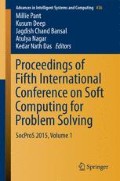Abstract
In this paper, we focus on the task of automatic text summarization. Lot of work has already been carried out on automatic text summarization though most of the work done in this field is on extracted summaries. We have developed a tool that summarizes the given text. We have used several NLP features and machine learning techniques for text summarizing. We have also showed how WordNet can be used to obtain abstractive summarization. We are using an approach that first extracts sentences from the given text by using ranking algorithm, by means of which we rank the sentence on the basis of many features comprising of some classical features as well as some novel ones. Then, after extracting candidate sentences, we investigate some of the words and phrases and transform them into their respective simple substitutes so as to make the final summary a hybrid summarization technique.
Access this chapter
Tax calculation will be finalised at checkout
Purchases are for personal use only
References
Nenkova. A., McKeown, K.: Found. Trends Inf. Retrieval 5(2–3), 103–233 (2011)
Amini, M.R., Usunier, N., Gallinari, P.: Automatic text summarization based on word-clusters and ranking algorithms. Computer Science Laboratory of Paris 6, 8 Rue du Capitaine Scott, 75015 Paris, France
Patil, V., Krishnamoorthy, M., Oke, P., Kiruthika, M.: A statistical approach for document summarization. Department of Computer Engineering Fr. C. Rodrigues Institute of Technology, Vashi, Navi Mumbai, Maharashtra, India
Yu, L., Liu, M., Ren, F., Kuroiwa, S.: A Chinese automatic text summarization system for mobile devices. Int. Inf. Inst. 13, 3(B) (2010)
Ren, F.: Automatic abstracting important sentences. Int. J. Inf. Technol. Decis. Making 4(1), 141–152 (2005)
Edmundson, H., Wyllys, R.: Automatic abstracting and indexing—survey and recommendations. Commun. ACM 4(5), 226–234 (1961)
Balabantaray, R., Sahoo, D., Sahoo, S.M.: Text summarization using term weights. Int. J. Comput. Appl. (0975–8887) 38(1), 10–14 (2012)
Pal, A., Maiti, P.K., Saha, D.: An approach to automatic text summarization using simplified Lesk algorithm and Wordnet
Chang, T., Hsiao, W.: A hybrid approach to automatic text summarization. In: 8th IEEE International Conference on Computer and Information Technology (CIT 2008), Sydney, Australia, 2008
Banerjee, S.: Adapting the Lesk algorithm for word sense disambiguation to WordNet
Kulkarni, A.R.: An automatic Text summarization using feature terms for relevance measure (2002)
Carlos, B.: WordNet.Br An Exercise of Human Language Technology Research. Dias-da-Silva Universidad estadual, Paulista, Brazil
Das, D.: Unsupervised part-of-speech tagging with bilingual Graph-Based projections. Carnegie Mellon University, Pittsburgh, PA 15213, USA
Manne, S., Fatima S.S.: A feature terms based method for improving text summarization with supervised POS tagging
Stanford NLP Group.: Stanford log-linear part of speech tagger. http://nlp.stanford.edu/software/tagger.shtml. Accessed 15 June 2009
Brill, E.: A simple rule-based part-of-speech tagger. In: Proceedings of the Third Conference on Applied Computational Linguistics. Association for Computational Linguistics (1992)
Dalianis, H.: SweSum-a text summarizer for Swedish. Technical Report, TRITA-NA-P0015, IPLab-174, KTH NADA, Sweden, 2000
Edmundson, H.P.: New methods in automatic extracting. J. Assoc. Comput. Mach. 16(2), 264–285 (1969)
Hull, D.A.: Information Retrieval Using Statistical Classification. Ph.D. dissertation, Stanford University, 1994
Marcu, D.: The Rhetorical Parsing, Summarization, and Generation of Natural Language Texts. Ph.D. dissertation, University of Toronto, 1997
Author information
Authors and Affiliations
Corresponding author
Editor information
Editors and Affiliations
Rights and permissions
Copyright information
© 2016 Springer Science+Business Media Singapore
About this paper
Cite this paper
Mudasir Mohd et al. (2016). Sumdoc: A Unified Approach for Automatic Text Summarization. In: Pant, M., Deep, K., Bansal, J., Nagar, A., Das, K. (eds) Proceedings of Fifth International Conference on Soft Computing for Problem Solving. Advances in Intelligent Systems and Computing, vol 436. Springer, Singapore. https://doi.org/10.1007/978-981-10-0448-3_27
Download citation
DOI: https://doi.org/10.1007/978-981-10-0448-3_27
Published:
Publisher Name: Springer, Singapore
Print ISBN: 978-981-10-0447-6
Online ISBN: 978-981-10-0448-3
eBook Packages: EngineeringEngineering (R0)

